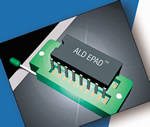| |
EPAD® - Electrically Programmable Analog Devices  |
| |
Introduction
|
 |
Advanced Linear Devices is committed to servicing the needs of low voltage, low power, high precision linear circuit applications. Many high performance and high precision instrumentation and control systems require trimming of circuit parameters. For example, critical components such as sensors are affected by minor variations in their production processes or their application environmental conditions such as temperature, altitude and humidity. Calibration or adjustment by electronic trimming of output signal of individual sensor units is in many cases the only way to achieve greater accuracy, control, and uniformity.
Hence, the EPAD (Electrically Programmable Analog Device) Technology was developed specifically by Advanced Linear Devices to address this need. EPAD is a new class of analog |
|
device, like the operational amplifier and the A/D converter. It is a unique CMOS-based device which, when used in combination with an inexpensive programmer, allows software-based analog circuit trimming in up to 100,000 discrete steps with resolution as low as 0.1 mV. EPAD MOSFETs are available in dual and quad versions; and they are also available in embedded standard linear function versions, such as EPAD Operational Amplifiers.
In engineering environments, EPAD can be programmed quickly and easily to fit the needs of a specific application. In production test environments, it can be programmed “in-system” - as an integral part of a circuit board assembly, thereby providing precise control over the entire system. |
| |
EPAD Technology
|
EPAD is an all solid state technology. This technology eliminates mechanical difficulties inherent in trimmer potentiometer technology. It is simpler, less expensive, easier to use; and in many cases far more accurate and reliable than standard trimmer potentiometer or micro-control circuitry. Simply defined, EPAD is a programmable integrated circuit that contains MOSFET transistors with programmable threshold voltages. Once programmed, the set voltage and current levels are stored indefinitely inside the device, even with power removed. Unlike microcontroller-based trimming, the EPAD requires no additional active circuitry, a tiny fraction of the power, and far less board space. The entire EPAD programming system consists of the EPAD devices, a low-cost programmer with software, and an adapter module.
EPAD MOSFETs can be programmed individually or in differential pairs. When programmed in differential pairs, one channel in the pair can be programmed to activate a certain condition, while the other activates its corollary, thus providing bi-directional control capability. This in turn enables a high degree of flexibility in the design of EPAD logic and functions. For example, a pair of EPAD MOSFETs can be used to adjust the input offset voltage of an operational amplifier. In this case, one EPAD device controls a circuit that increases the input offset voltage, while the other controls a circuit that decreases the input offset voltage. Bi-directional trimming can optimize system offset errors for the most demanding operational amplifier applications. |
| |
Learn more >>  |
| |
| EPAD FAQs >> |
| |
|
|
|